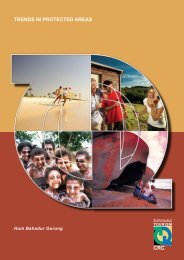icolls - Sustainable Tourism CRC
icolls - Sustainable Tourism CRC
icolls - Sustainable Tourism CRC
You also want an ePaper? Increase the reach of your titles
YUMPU automatically turns print PDFs into web optimized ePapers that Google loves.
ECOLOGY, THREATS AND MANAGEMENT OPTIONS FOR SMALL ESTUARIES AND ICOLLS<br />
Discussion<br />
Biological Diversity and Conservation Value of ICOLLs<br />
There have been several studies that have aimed to compare either the productivity or diversity of ICOLLs with<br />
those of permanently open estuaries (Pollard 1994b; Valesini et al. 1997; Sarre, Platell & Potter 2000).<br />
Significantly, many of these studies have concluded that despite their productivity, ICOLLs do not support as<br />
diverse invertebrate and fish assemblages as comparable permanently open estuaries (Pollard 1994b; Gray &<br />
Kennelly 2003). Despite these reports, we found remarkable diversity in invertebrate and fish taxa sampled<br />
across the five ICOLLs assessed in this study. Whilst no single ICOLL exhibited diversity like that found in<br />
large open estuaries, a significant and broad range of taxa was collected. Significantly, this combined<br />
biodiversity highlights the substantial conservation importance of ICOLLs in providing habitat for a<br />
taxonomically wide range of organisms (Watts & Johnson 2004).<br />
We recommend that a greater understanding of the role of ICOLLs in supporting and maintaining biological<br />
diversity throughout the coastal zone is required before management plans and objectives, which typically only<br />
focus on single systems, are implemented. For example, although diversity is low in some ICOLLs, they do<br />
provide important habitat for species that may not be found in neighbouring systems (Watts & Johnson 2004).<br />
We also provide, in this study, evidence that suggests the diversity of ICOLLs is highly variable through time,<br />
with opening regimes being the key driving process in influencing species composition (see below).<br />
Stable Isotope Signatures of Biota in ICOLLs<br />
The stable carbon and nitrogen isotope signatures measured in this study provide support of our proposed MPC.<br />
The less depleted δ13C signatures in consumer tissues from systems that are open to the ocean (in comparison to<br />
closed systems) supports our hypothesis that marine sources of carbon are being used by consumers in ICOLLs.<br />
In addition, with the exception of Tallows Creek, which has a strong sewage nitrogen signature (see next<br />
Chapter), there was also a tendency for consumers in open ICOLLs to have higher δ 15 N signatures than those<br />
from closed ICOLLs. As numerous researchers have shown that marine nitrogen isotope signatures are generally<br />
higher than terrestrial and freshwater nitrogen signatures (Thornton & McManus 1994), this finding offers an<br />
additional line of evidence supporting the MPC.<br />
Opening Regimes and Carbon Flow in ICOLLs<br />
On the basis of the stable isotope data presented in this chapter, we hypothesise that opening regimes play a<br />
strong structural and functional role in influencing food web patterns. For example, we found that even in closed<br />
ICOLLs, there are strong isotopic patterns that reveal significant marine carbon resource use by invertebrate and<br />
fish taxa. We suggest this finding is probably a consequence of the fact that marine carbon sources are more<br />
labile and accessible to consumers than are terrestrial carbon sources with high carbon-nitrogen ratios (Thornton<br />
& McManus 1994).<br />
This research provides the first succinct evidence for applying existing and novel conceptual models of<br />
carbon flow to ICOLL environments. We have demonstrated that ICOLL food webs can be characterised by a<br />
combination of riverine models, although the degree to which any model is relevant will depend largely on<br />
system entrance status at the time of assessment.<br />
Conclusions and Implications<br />
The consequences of these research findings are two-fold. First, we have demonstrated the importance of marine<br />
sources of carbon in supporting consumers in ICOLLs (even those closed to the ocean for extended periods of<br />
time). This has implications for fisheries production, recreational use and management of ICOLLs. For example,<br />
ICOLLs with more frequent marine connectance are likely to support more estuarine and coastal species, many<br />
of which are important food resources (Pollard 1994b; Gray 2001; Gray & Kennelly 2003).<br />
Second, we provide evidence to suggest that ICOLLs need to be managed across the coastal landscape with a<br />
view to maintaining coastal biodiversity. It is highly likely that systems managed independently of this<br />
landscape-level approach will lead to increased entrainment of entrances and subsequent and perhaps irreversible<br />
changes in community composition and patterns of carbon flow in these systems. Whilst managers may find<br />
opening ICOLL entrances mitigates flooding risks and flushes out algal blooms (Griffiths 1999), the long-term<br />
sustainable use of ICOLLs is more likely to be enhanced via a landscape scale rationalisation of entrance<br />
modifications. We recommend that if ICOLLs with important recreational and commercial fisheries interests are<br />
to be managed to sustain and enhance catches, then neighbouring systems should be retained in pristine<br />
24











